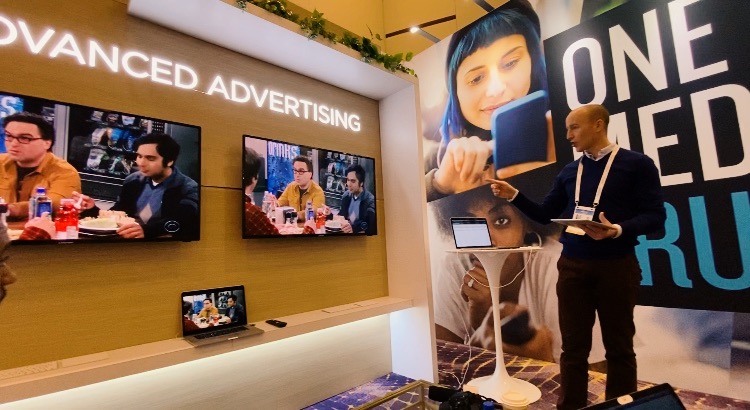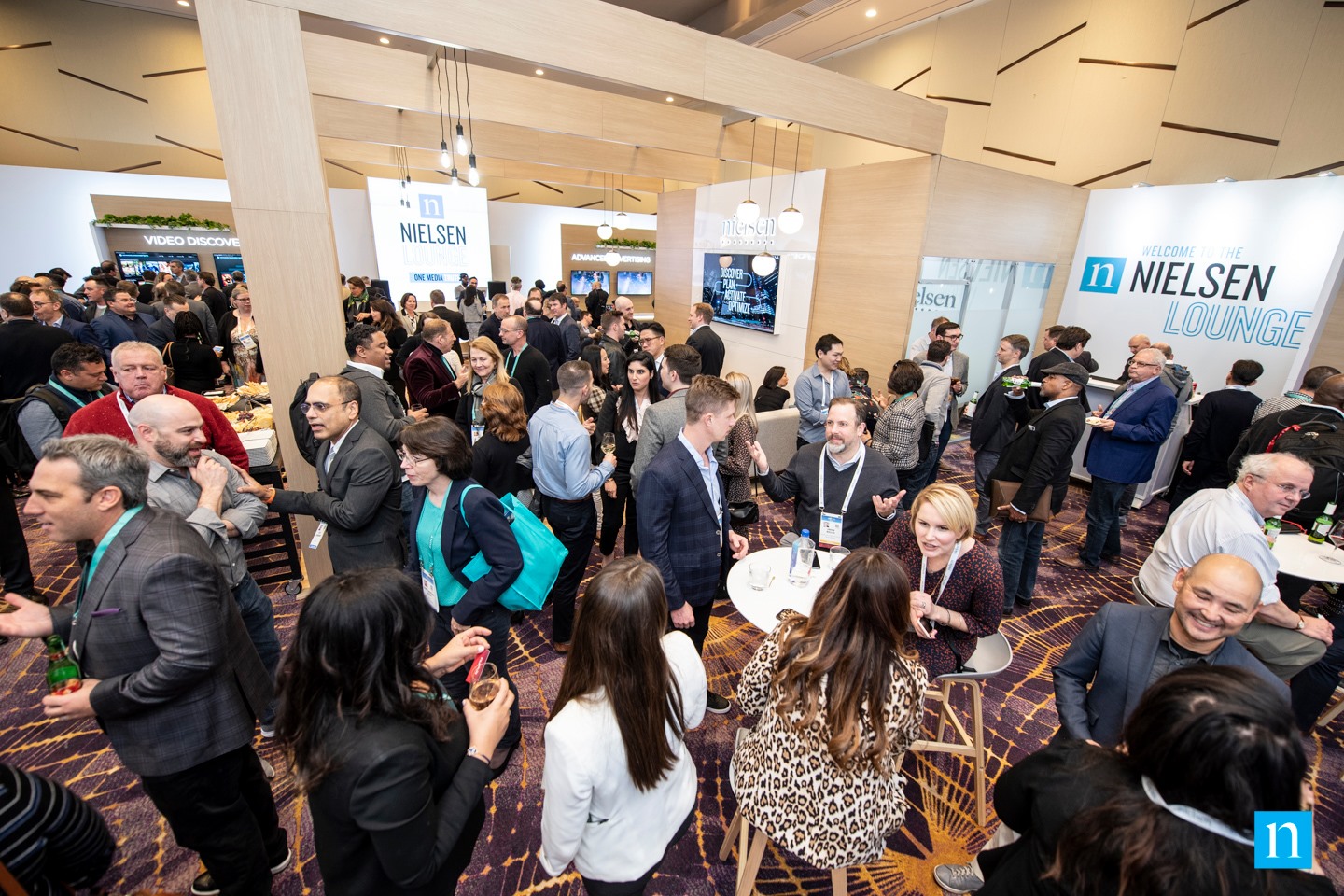Nielsen's Game-Changing Innovation, Tech, and Data on Display at CES 2020

Having acquired several key pieces of tech and added expertise around the addressable and advanced TV puzzle over the past few years, Nielsen unveiled its rollout plans for a game-changing national linear addressable TV solution from its recently formed Nielsen Advanced Video Advertising (AVA) group at CES 2020.
At a large and elegant demo area within CES's ad-focused C-Space, Nielsen demonstrated an early release of its addressable TV solution, powered by multiple acquisitions over the past few years. This solution could help to unlock one of the most frustrating barriers marketers have run into in the more than 15 years of addressable advertising: the ability to use national TV inventory at scale.
The first step for Nielsen, in the era of transparency and consumer privacy, was the acquisition of Qterics, a company that developed a solution for managing consumer privacy and consent, as well as remote software management. The system is jurisdiction aware and provides consumers with an easy method to opt out of data collection for purposes such as being tracked for segmented advertising to their household.

Another key development was Nielsen's acquisition of Gracenote in 2017, which brought industry-leading automatic content recognition (ACR) technology into its portfolio. Gracenote's advanced ACR capabilities power dynamic ad detection and enable seamless ad replacement within linear broadcast TV programming.
Then, in early 2019, Nielsen acquired Sorenson Media. Sorenson was an early innovator in the addressable TV space and offered a wealth of knowledge in inventory and yield management, identity and targeting, ad decisioning, and campaign management. These capabilities, combined with Gracenote's ACR and Qterics' consent management platform, enable Nielsen to move faster on its promise to deliver national linear addressable advertising to the media industry.
Nielsen is taking a methodical approach to the build-out and rollout of all this technology. This approach includes robust workflow analysis to understand how programmers prefer to manage their inventory and yield and how they want to make inventory available to the market. Nielsen's advanced inventory and yield management capabilities, combined with an advanced ad decisioning system enables programmers to avoid the "analog dollars to digital dimes" challenge and specify at what floor price (CPM) they are willing to allow a linear ad unit to be placed in the available pool of inventory for addressable.
The rollout of Nielsen's solution will take place in a controlled series of steps in lockstep with the programmers. The first step, currently in progress, is running several beta tests of the addressable technology by seven leading U.S. programmers: A+E, AMC, CBS, Discovery, FOX, NBCUniversal, and WarnerMedia. These media companies will evaluate how Nielsen's open technology interoperates with their existing and evolving workflows. Those TV networks will have the chance to review and experiment with the solution's full capabilities, including inventory and campaign management, audience targeting, ad decisioning, dynamic ad replacement, and C3/C7 measurement reconciliation.
Once the programmers involved are satisfied that the solution is ready to be deployed into consumer homes, Nielsen will go into Beta phase two, which involves an in-field rollout of the technology to thousands of devices and the solution being tested end-to-end together with the programmers, as well as selected agencies and brands. "It's all about the participants being happy about how the technology is working. They have existing workflows and need to be comfortable that the Nielsen solution fits into their desired way of working,"said Brian Jentz, senior vice president, advanced video advertising, at Nielsen.
The integration of these elements into a working and functional tech stack is a solid step forward for addressable TV. However, there remains a larger question as to just how much national linear inventory programmers are willing to make available for addressable TV, outside of copy splitting for full-unit buys. With a shrinking pool of premium television impressions, it's unlikely that tentpole events involving major sponsorships will be top of the inventory available list.
Nonetheless, the ability that Nielsen's Advanced Video Advertising brings to manage inventory yield and give marketers (ranging from TV to digital buyers) the ability to target their advertising is significant and noteworthy progress when coupled with OTT and other digital media targeting.
Lastly, Nielsen will leverage its knowledge and expertise in TV measurement to measure addressable advertising across both smart TVs and MVPD providers in a way that's transparent and protects the integrity of the current C3/C7 currency standards. By adjusting the currency to account for linear addressable TV ads, Nielsen will truly help the industry unlock addressable TV inventory at scale.
It is important to note that the Nielsen solution for advanced linear addressable will only work on a connected smart TV. According to the Consumer Tech Association, over 144 million smart TVs have been sold in the United States. Research from Parks Associates shows that approximately 77 percent of those sets are actually connected.
With all the tech pieces and a core team of experienced professionals passionate about the advanced TV space in place and poised for success, it appears that the industry has hit a significant milestone. With the opening of national linear inventory, all parties acting in good faith as partners — including Nielsen, agencies, and marketers — will give the advanced TV industry a strong push forward.
Striking a Chord With Metadata
During our time with Nielsen, we also learned how Gracenote's video metadata business is providing an innovative solution for the growing problem of content discovery in the era of peak video. This is made more complex with the explosion of streaming services and the overall fragmentation of consumer viewing platforms.
Gracenote's core expertise has always been in entertainment metadata, essentially deep, descriptive information about content that serves as the fuel for next-generation navigation, search, and discovery. Today, Gracenote focuses on three entertainment verticals: video, music, and sports.
The breadth and depth of Gracenote's video meta-tags go beyond cast information, character names, directors, episode descriptions, and images; they also include deep descriptions of content themes, moods, and scenarios, such as "highly intense action" or "deeply emotional." Today, Gracenote has data and imagery for tens of millions of video programs covering 85 countries and 35 languages.
Gracenote descriptive metadata, coupled with popularity metrics such as box-office return, number of awards, or social noise, are driving next-generation content recommendation capabilities that improve on collaborative filtering and the "watch this because you watched that" approach. Now, coupled with viewers' motivations and intentions, as well as their unique taste profiles, Gracenote is helping to power truly personalized viewing experiences.
"We sit at the center of the maelstrom to help people sort and provide clarity around what's going on in content discovery," explained Simon Adams, chief product officer of Gracenote, a Nielsen company. "The core thing now is not just the breadth of the data that we have, but also being much more granular on how we identify a piece of content."
Don't stop now! Stay in the know with more from NielsenDataInSites
Click the social buttons to share this story with colleagues and friends.
The opinions expressed here are the author's views and do not necessarily represent the views of MediaVillage.com/MyersBizNet.


